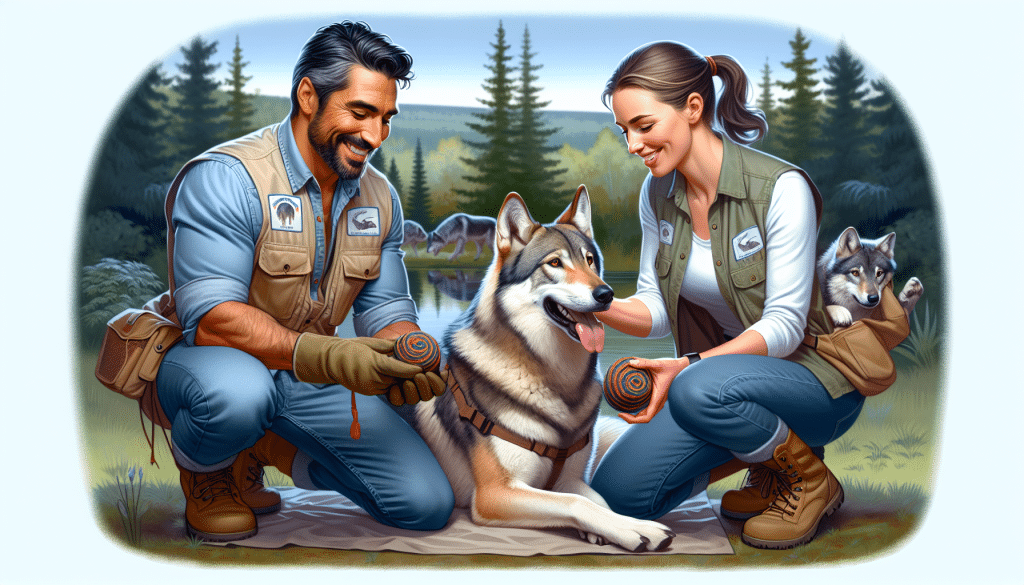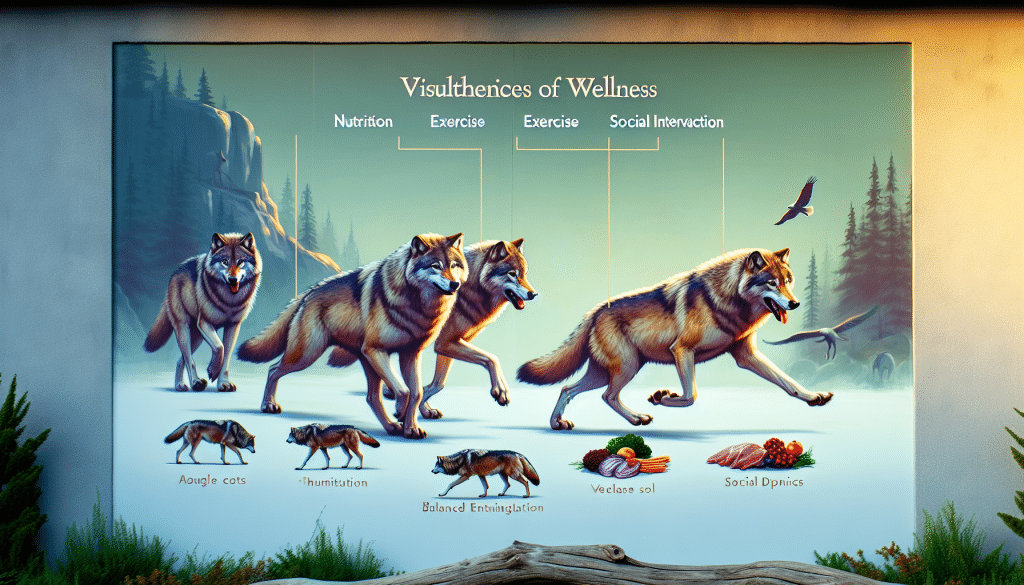In this article, you will have the opportunity to explore the natural habitat of wolves and learn about the importance of environmental enrichment for these magnificent creatures. By delving into the unique characteristics of their habitat, we will gain a deeper understanding of their behavior and the crucial role it plays in their overall well-being. Join us as we embark on a fascinating journey into the world of wolves and uncover the significance of providing them with a rich and stimulating environment.

Understanding Wolf Species and Distribution
Wolves, belonging to the Canidae family, are one of the most iconic apex predators in the world. They are widely distributed across various continents, encompassing a diverse range of habitats. Understanding the global distribution of wolves is crucial in gaining insight into their species and conservation efforts.
Global Distribution of Wolves
Wolves have historically occupied a vast range extending from the northern hemisphere to the southern hemisphere. They can be found in North America, Europe, Asia, and even parts of Africa. However, their distribution has been greatly influenced by human activities and habitat degradation, resulting in localized populations in certain regions.
Differences Between Gray, Red, and Ethiopian Wolves
Among the various wolf species, the gray wolf (Canis lupus) is the most widespread and well-known. It has a diverse range of subspecies and is found in North America, Europe, and Asia. Red wolves (Canis rufus) are native to the southeastern United States and are critically endangered. Ethiopian wolves (Canis simensis) are unique to the Ethiopian highlands and are the rarest canid species in the world.
These wolf species exhibit distinct physical and behavioral characteristics. Gray wolves are known for their adaptability and social structures, living in packs and displaying complex hierarchical behaviors. Red wolves, on the other hand, are smaller in size with a reddish-brown coat, and they typically form smaller family units. Ethiopian wolves have a slender build and are primarily solitary, inhabiting the Ethiopian mountains.
Influence of Climate and Geography on Wolf Habitat
Climate and geography play a significant role in determining wolf habitat. Wolves are highly adaptable and can thrive in a wide range of ecosystems such as forests, tundra, mountains, and even deserts. However, each species of wolf has specific habitat preferences influenced by their physiological and ecological requirements.
For instance, gray wolves prefer forested areas with access to prey and water sources. They have also been observed in Arctic tundra regions, adapting to cold and harsh climatic conditions. Red wolves, being native to the southeastern United States, primarily inhabit coastal marshes and swamps. Ethiopian wolves are uniquely adapted to the Afroalpine ecosystem found in the highlands of Ethiopia.
Understanding the influence of climate and geography on wolf habitat is vital for conservation efforts and effective management of these majestic predators.
Characteristics of Wolf Habitats
Wolf habitats consist of various primary features that are essential for their survival and successful reproduction. These features include territory size, prey availability, and suitable ecological conditions.
Primary Features of Wolf Territories
Wolves establish territories, which provide them with defined areas for hunting, denning, and raising their offspring. The size of wolf territories varies depending on factors such as prey availability, habitat quality, and pack dynamics. It can range from tens to hundreds of square miles, encompassing diverse habitats and resource-rich areas.
Within these territories, wolves establish core areas that are crucial for their denning and pup-rearing activities. These core areas are typically located in secluded and protected areas, such as dense forests or rugged terrain. Wolves exhibit strong territoriality and defend their territories against intruding packs or individuals.
Adaptability to Diverse Ecosystems
One remarkable characteristic of wolves is their adaptability to various ecosystems. They have the ability to thrive in different habitats, ranging from dense forests to arctic tundra. This adaptability is due to their highly flexible behavior, physiological adaptations, and social cohesion.
In forested regions, wolves navigate through the dense vegetation using their strong senses and agile bodies. They rely on their keen hearing and sharp vision to locate and track their prey effectively. In comparison, wolves dwelling in the arctic tundra have unique adaptations to cope with extreme cold, such as a dense double coat and shorter legs for better heat retention.
Role of Prey Availability in Habitat Selection
The availability of prey species is a crucial factor influencing wolf habitat selection. The primary diet of wolves consists of ungulates such as moose, elk, deer, and caribou. The abundance and distribution of these prey species greatly influence the distribution and density of wolf populations.
In areas with abundant prey, wolves can establish stable and larger territories. In contrast, regions with limited prey resources may lead to smaller territories and increased competition among packs. Human activities, such as hunting and habitat fragmentation, can disrupt the natural balance of prey availability, impacting wolf populations.
Understanding the interplay between wolf habitat and prey availability is vital for preserving healthy ecosystems and ensuring the long-term survival of both predators and prey.

The North American Wolf Habitats
North America has been a significant stronghold for wolf populations, with various species and subspecies historically inhabiting the continent. However, the distribution and abundance of these wolves have been greatly impacted by human activities.
Historical Range of Wolves in North America
In the past, wolves were found across most of North America, ranging from the Arctic to Mexico and from the Atlantic to the Pacific. Their distribution covered diverse habitats, including forests, grasslands, and tundra regions. Gray wolves, specifically, were widespread, occupying a large portion of the continent.
Unfortunately, due to habitat loss, hunting, and predator control programs, wolf populations in North America dramatically declined. By the mid-20th century, they were almost eradicated from the United States, with only a few remnant populations remaining in isolated regions.
Current Wolf Populations in the United States and Canada
With concerted conservation efforts, wolf populations in North America have made a remarkable recovery. The reintroduction of gray wolves in the Yellowstone National Park and central Idaho in the 1990s played a pivotal role in restoring their populations in the United States. Today, gray wolves can be found in several states, including Montana, Wyoming, Idaho, Wisconsin, and Michigan.
In Canada, wolves have managed to maintain relatively stable populations, especially in remote regions such as the Canadian Rockies and the Northwestern Territories. These populations are vital for the genetic diversity of wolves in North America.
Conservation Efforts in North American Wolf Habitats
Conservation organizations, government agencies, and local communities have collaborated to implement measures to protect and restore wolf habitats in North America. These efforts include habitat restoration, predator management plans, and public awareness campaigns.
Protected areas such as national parks and wildlife refuges have been established to provide safe havens for wolves and their prey. Additionally, initiatives focused on promoting coexistence between wolves and humans have helped mitigate conflicts and foster support for conservation.
Continued conservation efforts are essential to ensure the long-term survival of North American wolf populations and to maintain the ecological balance they bring to their habitats.
The European Wolf Habitats
Europe is home to a variety of habitats that support wolf populations. The recovery of wolves in Europe showcases the resiliency and adaptability of these apex predators.
Wolf Population Recovery in Europe
In the past few decades, European wolf populations have made a remarkable recovery after facing severe decline and local extinctions. Widespread habitat loss and persecution resulted in wolves being confined to small pockets of remote wilderness.
However, conservation programs, legal protections, and public attitudes towards wolves have undergone substantial changes. As a result, wolf populations have expanded and recolonized regions where they were once absent. Countries such as Poland, Spain, Italy, and Romania now host significant populations of European wolves.
Human Influences on European Wolf Habitats
Human activities have had a profound impact on European wolf habitats. Habitat loss and fragmentation due to urbanization, agricultural expansion, and infrastructure development have altered the natural landscape, dividing wolf habitats into smaller and isolated pockets.
Additionally, the rewilding of abandoned farmlands and the reintroduction of natural prey species, such as wild boars, have played a critical role in restoring wolf habitats. These initiatives have helped provide ample food sources and suitable environments for wolves to thrive.
Protected Areas and Wildlife Corridors
To ensure the long-term conservation and viability of European wolf populations, protected areas and wildlife corridors have been established. Protected areas, such as national parks and nature reserves, provide essential habitats for wolves and other wildlife species.
Wildlife corridors, on the other hand, are vital for connecting fragmented habitats and allowing wolves to disperse and establish new territories. These corridors facilitate gene flow and maintain genetic diversity, thus contributing to the long-term survival of wolf populations.
Efforts to protect and restore European wolf habitats continue to be crucial, as they play a critical role in maintaining the ecological balance and biodiversity of the continent.

The Asian Wolf Habitats
Asia is home to a wide range of habitats that support diverse wolf populations. However, human-wolf conflict and habitat loss pose significant challenges to their conservation.
Geographical Range of Wolves in Asia
Wolves are found across various regions in Asia, including Russia, Mongolia, China, and India. They occupy a diverse range of habitats, from the Siberian tundra to the arid steppes, and from the dense forests of the Russian Far East to the high altitudes of the Himalayas.
Asian wolves demonstrate remarkable adaptability, thriving in harsh and challenging environments. However, their populations are threatened by habitat degradation, human-wildlife conflict, and poaching.
Human-Wolf Conflict in Asia
Asia faces significant challenges when it comes to human-wolf conflict. Increasing human populations, encroachment into wildlife habitats, and competition over resources have led to conflicts between wolves and local communities.
Predation on livestock, such as sheep and cattle, has been a major point of contention, leading to retaliatory killings of wolves. These conflicts not only impact wolf populations but also hinder efforts to promote coexistence and conservation.
Conservation Status of Asian Wolves
The conservation status of Asian wolves varies depending on the species and region. Some populations, such as the Siberian and Indian wolves, are classified as “least concern” by the International Union for Conservation of Nature (IUCN), indicating relatively stable populations.
However, several subspecies, such as the Hokkaido wolf in Japan and the Arabian wolf in the Middle East, are critically endangered and face imminent extinction. Urgent conservation efforts, including habitat protection, anti-poaching measures, and community engagement, are necessary to safeguard these endangered populations.
Preserving and restoring Asian wolf habitats is paramount to conserving these magnificent creatures and the unique ecosystems in which they reside.
Wolf Habitat in the Arctic: The Tundra Wolves
The Arctic tundra is a harsh and challenging environment, yet it is home to resilient and uniquely adapted wolf populations.
Adaptations to the Cold
Tundra wolves have evolved to withstand the extreme cold of the Arctic. They possess several adaptations that allow them to thrive in sub-zero temperatures. These adaptations include a thick double coat, consisting of a coarse outer layer and a dense underlayer, which provides excellent insulation. Tundra wolves also have a compact body structure, shorter legs, and a robust build that aids in conserving body heat.
Their fur changes color with the seasons, blending into the snow-covered landscape during the winter months. This camouflaging adaptation helps them efficiently hunt their prey, such as caribou and muskoxen, without being detected.
Prey and Predation in Arctic Conditions
Tundra wolves primarily rely on large herbivores, such as caribou, muskoxen, and Arctic hares, for sustenance. These ungulates are well-adapted to the harsh conditions of the tundra and form the foundation of the Arctic food web.
The complex relationship between predators and prey in the Arctic is a delicate balance. Wolves play a crucial role in regulating ungulate populations, preventing overgrazing, and maintaining ecosystem health. They selectively target weaker and older individuals, which helps to strengthen the overall gene pool of the prey species.
Impact of Climate Change on Tundra Wolves
Climate change poses a significant threat to tundra wolf habitats. As temperatures rise and the Arctic experiences rapid melting of sea ice and permafrost, the delicate balance of the ecosystem is disrupted.
These changes affect the availability and distribution of prey species, altering the carrying capacity of the habitat for wolves. The reduction in sea ice also allows for increased human activities in the Arctic, potentially leading to habitat degradation and disturbance for tundra wolf populations.
To mitigate the impact of climate change on tundra wolves, proactive measures such as reducing greenhouse gas emissions, protecting critical habitats, and promoting sustainable human practices are essential.
Wolf Habitat in Forested Regions
Forests provide vital habitats for diverse wolf populations worldwide. These habitats offer unique challenges and opportunities for wolves to thrive.
Importance of Forest Cover for Wolves
Forested regions are crucial for wolf populations due to the abundance of prey and suitable denning sites they provide. Wolves are well-adapted for navigating through dense vegetation, utilizing their sharp senses and agile bodies to track and capture prey effectively.
The cover provided by forests also offers protection from harsh weather conditions and reduces the risk of predation by other large carnivores. Forested habitats allow wolves to establish stable territories and engage in complex social behaviors within their packs.
Hunting Strategies in Dense Forests
Wolves have developed specialized hunting strategies to pursue and capture prey in dense forest environments. They often hunt in coordinated packs, utilizing their superior teamwork and communication skills to bring down larger ungulates.
In forested regions, wolves employ a variety of techniques such as ambushing, coursing, and fatigue-based hunting. They use the cover and obstacles provided by the trees to their advantage, strategically pursuing and surrounding their prey. This hunting behavior demonstrates the remarkable agility and adaptability of wolves in navigating complex terrains.
Deforestation and Its Effects on Wolf Populations
Deforestation poses a significant threat to forest-dwelling wolf populations. As human activities expand, forests are being cleared at alarming rates, leading to habitat loss and fragmentation. These activities disrupt the natural ecological balance and threaten the long-term survival of wolves.
Deforestation not only diminishes the availability of suitable habitat for wolves but also results in the loss of cover and prey base. Wolves are forced to navigate through fragmented habitats, increasing the risk of conflict with humans and other predators.
Conservation efforts focused on minimizing deforestation, restoring degraded forests, and promoting sustainable land-use practices are crucial to safeguarding forested wolf habitats worldwide.
Mountainous Wolf Habitats
Mountain ranges present unique challenges and opportunities for wolves, with high-altitude habitats requiring specialized adaptations.
High Altitude Adaptations
Mountain-dwelling wolves face extreme altitudes, cold temperatures, and rugged terrains. These challenging conditions have influenced their physical and behavioral adaptations. Wolves living in mountains often have longer legs, which aid in traversing steep slopes and rugged terrain.
Their lung capacity and cardiovascular systems are highly adapted to cope with the thin air at high altitudes. Thick fur provides insulation against the cold, and their strong claws enable them to navigate rocky surfaces.
Predator-Prey Dynamics in the Mountains
Mountains provide a diverse range of prey species for wolves, including mountain goats, bighorn sheep, and deer. These agile and sure-footed ungulates have also adapted to the challenging mountainous environments. Wolves must employ unique hunting strategies to capture their elusive prey.
Predator-prey dynamics in mountainous habitats are intricate, with wolves and their prey engaging in a constant evolutionary arms race. Wolves employ their intelligence, agility, and coordination to outwit and overpower their prey, while ungulates develop behaviors and adaptations to evade predation.
Challenges of Habitat Fragmentation
Mountainous habitats are prone to habitat fragmentation, primarily due to human activities such as infrastructure development and tourism. Fragmented habitats hinder the movement and dispersal of wolves, potentially isolating populations and limiting gene flow.
The loss of connectivity between mountain ranges can lead to reduced genetic diversity and increased vulnerability to environmental changes. It is crucial to establish wildlife corridors and protect critical habitats to ensure the long-term survival of wolves in these majestic landscapes.
Habitat Enrichment for Wolves
In captivity, providing proper habitat enrichment is essential for the physical and mental well-being of wolves.
Elements of Enrichment in Captivity
Enrichment activities aim to simulate natural behaviors and provide mental stimulation for captive animals. For wolves, habitat enrichment can include the provision of varied and challenging terrain, hiding spots, and opportunities for exploration.
Environmental stimuli such as scents, novel objects, and food puzzles can encourage natural foraging behaviors and mental engagement. Wolves also benefit from opportunities for social interaction with conspecifics, which mimic the social dynamics of wild pack life.
Importance of Enrichment for Captive Wolf Welfare
Enrichment plays a crucial role in maintaining the physical and psychological health of captive wolves. Without appropriate stimulation, wolves can become bored, frustrated, or develop repetitive behaviors.
Enrichment activities help alleviate stress, encourage natural behaviors, and promote psychological well-being. Providing a stimulating and enriching environment for captive wolves mimics their natural habitat, promoting their overall welfare.
Mimicking Natural Habitat Features in Zoos and Sanctuaries
Zoos and sanctuaries housing captive wolves strive to replicate natural habitat features as closely as possible. Enclosures often include rocky outcrops, vegetation, and water features, providing wolves with a sense of security and opportunities for exploration.
Additionally, rotational feeding practices, scent enrichment, and the introduction of novel objects mimic the unpredictability of the wild, encouraging natural foraging and investigative behaviors.
By creating enriched environments that mimic natural habitat features, zoos and sanctuaries play a significant role in promoting the well-being of captive wolves and raising awareness about their conservation needs.
Habitat Conservation and Restoration Efforts
Preserving and restoring wolf habitats is vital for the long-term survival of these iconic predators. Various initiatives and projects have been implemented to protect and restore wolf habitats worldwide.
Legal Protection for Wolves and Their Habitats
Many countries have implemented legal frameworks and policies to protect wolves and their habitats. These measures aim to regulate hunting, prevent habitat destruction, and promote coexistence between humans and wolves.
Protected areas, such as national parks and wildlife reserves, provide legal safeguards for wolf populations and their ecosystems. International treaties and conventions, such as the Convention on Biological Diversity and the Convention on the Conservation of Migratory Species of Wild Animals, also contribute to the conservation of wolf habitats on a global scale.
Rewilding and Reintroduction Projects
Rewilding initiatives and reintroduction projects have been effective in restoring wolf populations and their habitats. These projects involve the release of captive-bred or translocated wolves into suitable areas, promoting the natural recolonization of historically occupied territories.
Rewilding and reintroduction efforts not only benefit wolf populations but also help restore ecological balance and foster biodiversity in their habitats. These projects require careful planning, collaboration between multiple stakeholders, and ongoing monitoring to ensure the success and long-term viability of reintroduced populations.
Community-based Conservation Initiatives
Community engagement and participation in wolf conservation efforts are crucial for successful habitat conservation. Collaborative approaches that involve local communities, indigenous peoples, and stakeholders foster a sense of ownership and stewardship of wolf habitats.
Community-based conservation initiatives include education programs, awareness campaigns, and the establishment of conservation agreements with local communities. By involving communities in decision-making processes, conflicts can be mitigated, and sustainable practices can be embraced, contributing to the preservation and restoration of wolf habitats.
In conclusion, understanding wolf species and their distribution is paramount to conserving their habitats and ensuring their long-term survival. From the vast forests of North America to the Arctic tundra and the mountains of Asia and Europe, wolves have adapted to thrive in a variety of ecosystems. Ongoing efforts to protect and restore wolf habitats, along with community involvement and legal protections, are crucial to securing a future where wolves can continue to roam their natural habitats, playing their vital ecological roles as apex predators.



